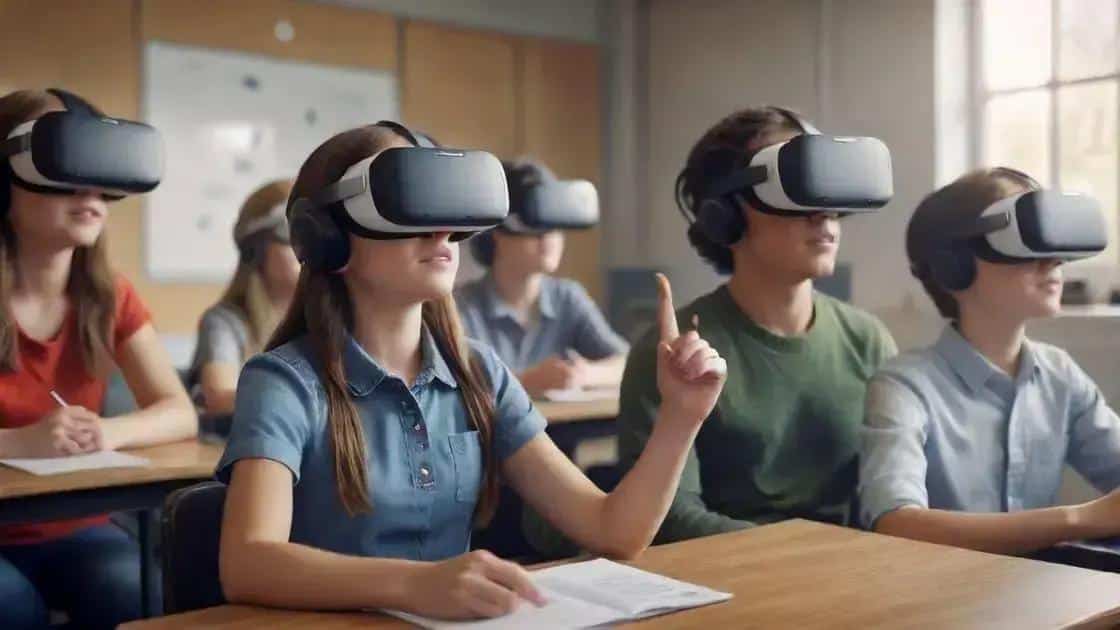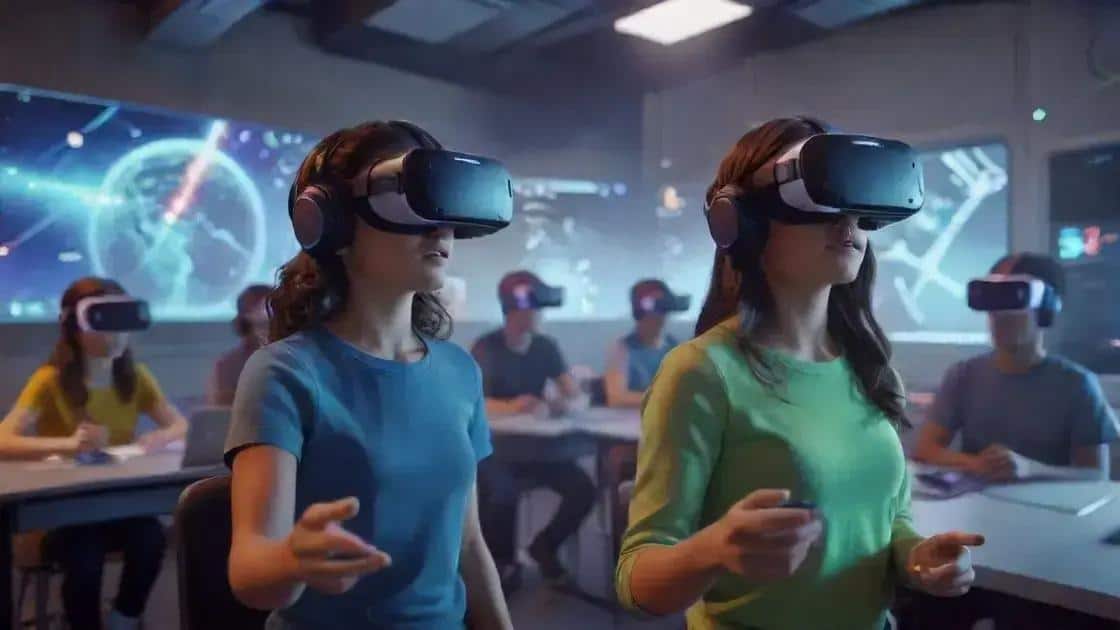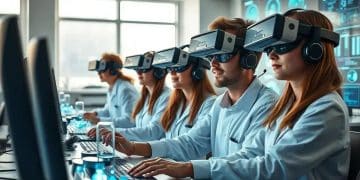VR learning environments trends: what’s next for education?

VR learning environments trends are reshaping education by enhancing student engagement, enabling personalized learning experiences, and promoting collaboration, while overcoming challenges like cost and technology access is essential for broader implementation.
VR learning environments trends are reshaping education, offering new ways for students to engage and learn. Have you thought about how immersive experiences can change your classroom?
Emerging technologies in VR learning environments
Emerging technologies in VR learning environments are paving the way for a new era of education. With advancements in hardware and software, schools are now able to create immersive experiences that benefit students in various ways.
Key Technologies Shaping VR Learning
Several technologies are playing a significant role in the development of VR learning environments. These innovations enhance user experience and make learning more interactive.
- Artificial Intelligence: AI is used to tailor VR experiences to individual learning styles, helping students grasp complex concepts more effectively.
- 3D Modeling and Animation: This technology provides realistic simulations, making lessons engaging and relatable.
- Cloud Computing: Enables access to VR content anywhere, allowing for flexible learning.
- Mobile VR: Offers the ability to learn on-the-go with affordable, portable VR devices.
As these technologies evolve, educators have the opportunity to redefine teaching strategies. For instance, using augmented reality alongside virtual reality can enhance the learning experience even more. With AR, students can interact with physical objects while also engaging with digital content, further solidifying their understanding.
The integration of biometric feedback could also transform VR learning environments. This technology measures student engagement and emotional responses, providing educators with valuable insights to enhance instruction. Imagine a classroom where the VR system adapts in real-time to keep students engaged!
Moreover, the expansion of collaborative VR platforms allows students from different locations to learn together in a single virtual space. This feature promotes teamwork and communication skills while also exposing students to diverse perspectives.
The future of education is bright with these emerging technologies. Schools that adopt VR learning environments will not only enrich their curriculum but also prepare students for the demands of tomorrow’s workforce.
Benefits of VR for student engagement

Engaging students is crucial for effective learning, and VR offers unique benefits that can captivate young minds. By immersing students in realistic environments, virtual reality encourages active participation, which leads to deeper understanding and retention.
Enhanced Motivation
One major benefit of VR is that it boosts student motivation. When students can explore historical sites or dive into the ocean from their classroom, they are more excited to learn. This enthusiasm can translate into better performance and participation in lessons.
- Creates a sense of adventure through immersive experiences.
- Encourages curiosity by allowing exploration of new ideas.
- Uses gamification elements to make learning fun and interactive.
Additionally, VR caters to different learning styles. Some students are visual learners, while others thrive with hands-on experiences. Through virtual simulations, each student can approach the lesson in a way that suits their preferences. This varied engagement reinforces concepts and supports comprehensive learning.
Improved Collaboration
Another advantage of VR is that it fosters collaboration among students. In a virtual space, students can work together on projects regardless of their physical location. This teamwork not only builds social skills but also teaches students the value of working as part of a team.
Moreover, collaborative VR environments can be designed to solve real-world problems. Students can share ideas in real time, making learning a collective and interactive process. By collaborating in VR, students develop crucial communication skills and learn to appreciate diverse viewpoints.
As students engage with VR technology, they also experience increased focus. Unlike traditional learning methods, VR minimizes distractions and keeps students involved in the task at hand. This focused environment helps them absorb complex information without feeling overwhelmed.
Ultimately, the advantages of utilizing VR for student engagement are substantial. From fostering motivation to improving collaboration and focus, VR is changing how students interact with learning materials.
Challenges and barriers to VR integration
While the potential of VR in education is vast, there are several challenges and barriers to its integration in learning environments. Understanding these obstacles is essential for schools hoping to leverage this technology.
High Costs of Implementation
One of the biggest hurdles is the cost. VR hardware and software can be expensive, making it hard for many schools to adopt. Many institutions struggle to find funding for the necessary equipment and ongoing maintenance. This often results in limited access for students.
- Initial investment for VR headsets and computers can be high.
- Software licenses and content creation require additional funding.
- Regular updates and maintenance can strain budgets.
Another challenge arises from the need for adequate training. Teachers and staff must be comfortable using these new technologies to effectively integrate VR into their lessons. Without proper training, educators may hesitate to utilize VR, causing missed opportunities for enhancing the learning experience.
Limited Access to Technology
Access to technology is also a concern. Even though VR has become more mainstream, not all students may have the same level of access to devices or the internet. This disparity can create inequities within the classroom, where some students benefit from immersive experiences while others do not.
Moreover, schools in rural or underserved areas might face greater barriers in acquiring VR technologies. This situation can widen the educational gap between different communities, leaving some students behind.
Technical difficulties can also arise during VR sessions, such as connectivity issues or device malfunctions. Such problems can disrupt learning and lead to frustration for both students and teachers. Furthermore, the need for an appropriate physical space for VR activities can limit its use. Classrooms must be equipped with enough room to ensure safety during VR interactions.
Sensitivity to different learning styles is crucial as well. While VR can engage many students, some might find the technology overwhelming or distracting. Teachers must balance traditional teaching methods with VR to accommodate diverse learner needs. Finding the right mix of both can be challenging.
Future trends in virtual reality for education

The future of virtual reality (VR) in education looks promising, with several trends emerging that will shape how students learn. As technology advances, we can expect to see VR becoming an integral part of the educational landscape.
Increased Personalization
One significant trend is the move towards personalized learning experiences. With the help of adaptive learning technologies, VR can be tailored to meet the specific needs of individual students. This personalization helps learners progress at their own pace, ensuring that they fully grasp the material.
- Customization of learning paths based on student performance.
- Immediate feedback to help learners improve.
- Opportunities for students to explore subjects of interest more deeply.
Another exciting aspect of the future is the integration of AI technology within VR platforms. AI can analyze how students interact with learning materials and adapt the VR experience accordingly. This data-driven approach will create more effective learning environments, allowing teachers to focus on areas where students struggle.
Cross-Disciplinary Learning
Cross-disciplinary learning is becoming increasingly popular, and VR can facilitate this trend. Students can explore connections between various subjects, such as science, history, and art, within immersive environments. For example, a student studying a historical event might virtually visit that time period using VR.
This approach not only fosters a deeper understanding but also encourages critical thinking. By making connections across different fields, students gain a well-rounded perspective on their education.
Additionally, as the technology evolves, we might see the rise of collaborative VR educational experiences. Students from different parts of the world could work together on projects in shared virtual environments, promoting cultural awareness and teamwork. This global classroom experience can enrich their learning journey.
Moreover, the implementation of haptic feedback could revolutionize how students interact with virtual environments. By simulating touch and movement, learners will have more realistic experiences, making complex concepts easier to understand.
As these trends continue to develop, it’s clear that VR will play a vital role in transforming education. The possibilities for enhancing student engagement and understanding through immersive technology are vast, making the future of learning an exciting prospect.
In conclusion, the future of virtual reality (VR) in education is bright and full of potential. As technology continues to evolve, we can expect personalized learning experiences, increased collaboration, and immersive environments that engage students like never before. By embracing VR, teachers can create dynamic educational experiences that cater to diverse learning needs. The commitment to overcoming obstacles such as costs and access will ensure that all students benefit from these advancements. Overall, VR is set to transform education, making it more exciting and effective for future generations.
FAQ – Frequently Asked Questions about Virtual Reality in Education
What are the benefits of using VR in education?
VR enhances student engagement, enables personalized learning experiences, and fosters collaboration among students.
What challenges do schools face when integrating VR?
Challenges include high costs of hardware, the need for proper training for teachers, and limited access to technology for some students.
How can VR personalize learning experiences?
VR can adapt to individual learning styles and paces, allowing students to explore topics that interest them in a way that suits their needs.
What future trends can we expect with VR in education?
Future trends include increased personalization, the use of AI to enhance learning experiences, and more collaborative virtual environments.





